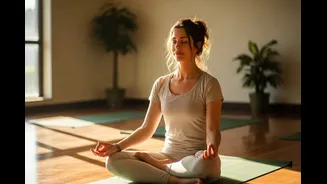Meditation for stress relief and inner peace doesn’t happen all at once. It takes time—because meditation is not an activity, but the outcome of gradual inner progress.
Meanwhile, life keeps happening:
setbacks, temptations, emotional ups and downs. The mind is a bundle of impulses, emotions, samskaras (innate tendencies) and habitual reactions. For it to be at peace, there should be a lack of inner turmoil.
Long-term, this is Yoga’s main goal—vritti nirodha, as Patanjali puts it—the restraint of mental fluctuations. It is synonymous with inner tranquility, a still mind that remains calm and steady even in the face of adversity.
But how does one stay steady when everyday stress and distractions are constant and cumulative? The obvious answer is: through simultaneous techniques for immediate and sustained relief.
Two Yoga practices that make a remarkable difference and work well in anxious and disturbed situations are:
A simple version of Mukha Bhastrika Pranayama for instant relief from acute stress.
Yoni Mudra, a Pratyahara technique that reins in the senses over time, and prepares the mind for meditation.
Before we learn the practices, it helps to understand why the mind gets agitated so easily.
The Inherently Restless Mind
You decide to sit and work, but your mind coaxes you to watch a movie first. No amount of repression, reasoning or self-talk seems to work. The mind craves stimulation—even if it’s inappropriate for the situation. It not only craves stimulation but also recoils and reacts negatively to whatever it dislikes.
The five senses (sight, smell, hearing, taste, and touch) never stay still. They constantly reach outward and create cravings, desires, aversions and so on. They pull the mind in different directions.
This makes the mind distracted and easily agitated, and as it moves rapidly, it disturbs the forces in the body. As a result, consciousness remains unfocussed, energy becomes scattered, and meditation becomes impossible.
The antidote for this turbulence is Pratyahara—withdrawal of the senses—the fifth limb in Patanjali’s eightfold path. This inward turning prepares the mind for deeper focus.
Pranayama and conscious relaxation are often spoken about, but Pratyahara is not emphasised enough. Pranayama calms by slowing the breath, while Pratyahara calms by cutting out distractions. Pratyahara is a foundational requirement for meditation to be successful.
PRACTICE 1: INSTANT STRESS RELIEF
Blasting Stress With This Version of Mukha Bhastrika Pranayama
How does one remain calm when intense emotions surge—anxiety, indignation, tension, anger?
According to leading Medical Yoga expert Dr Nagarathna Raghuram, a simple one-minute technique can help “blast out” pent-up emotional energy. This works very well because the forceful exhalation and vocalisation remove negative or tamasik energy instantly.
How To Do It
1. Sit in a relaxed, comfortable position. Bring both hands in front of the face, letting them hang loosely from the wrist.
2. Use short, forceful exhalations — along with coordinated downward movements of the hands, as though the hands are nudging the stress downwards. Do this 10 times.
3. Now focus on the abdomen. Take a deep breath in, and breathe out. The abdomen must get fully inflated and fully deflated.
4. Lastly, breathe in again. While breathing out, make a moaning sound of ‘aaa’. Focussing on the sound resonance within the bloated abdomen is what gives relief and releases tension.
5. One round is usually enough, but it can be repeated up to three times if necessary.
PRACTICE 2: CALMING AND STEADYING THE MIND
Turning Inward with Yoni Mudra — Symbol of the Embryo
Of all methods that steady the senses, Yoni Mudra is exceptionally effective. It is an important Pratyahara technique described in the Gheranda Samhita, and some modern lineages relate it to Shambhavi Mudra.
I learnt this practice from Pandit Shambhunath, a renowned yoga teacher who contributed to the Yoga-for-Health movement in India between the 1960s and 1990s. According to him, Yoni Mudra “functions as a symbolic seal to shut off the sense organs”.
In his book Stress Management Through Yoga, he highlights Yoni Mudra as a practice known to give rest to a turbulent mind, conserve energy, and induce joy in solitude.
The word ‘yoni’ refers to the embryo. Yoni Mudra symbolically draws the mind inward and returns it to the womb’s safety, solitude and silence.
How To Do Yoni Mudra
1. Sit in Sukhasana or Vajrasana (easy pose or thunderbolt pose).
2. Bring your hands to your face, elbows in line with the shoulders.
3. Close your eyes.
4. Lightly place:
thumbs on the ear openings,
index fingers on the eyelashes,
middle fingers on either side of the bridge of the nose,
ring fingers above the upper lip, and
little fingers below the lower lip.
5. Stay in this position for 5–10 minutes with normal breathing.
6. Keep your attention either on the breath or on a subtle sound in the ears or body.
(Avoid if you have acute depression or cervical spondylitis.)
Last But Not Least—The Ethical Foundation
For a peaceful mind and restful sleep, it is said that good conduct and a clear conscience are the softest pillows.
Yogic practices work best when the mind is free from inner conflict. This is why no discussion on stress relief through Yoga is complete without the ethical limbs of Yama and Niyama. These help remove inner conflicts and purify intentions, making all other yogic practices far more effective.
The author is a journalist, cancer survivor and certified yoga teacher. She can be reached at swatikamal@gmail.com.









